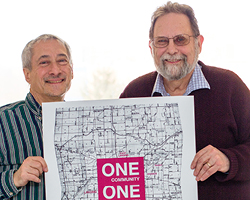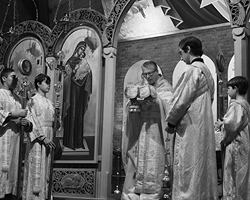Book Collaboration Showcases the Diversity of Local Belief
- Howard Bossen, Ph.D.
- Professor, School of Journalism
- College of Communication Arts and Sciences
- Eric Freedman, J.D.
- Associate Professor, School of Journalism
- Knight Chair, Knight Center for Environmental Journalism
- College of Communication Arts and Sciences

Howard Bossen and Eric Freedman
This past fall, two professors from the MSU School of Journalism shepherded a project to completion with the publication of a book, One Community, One Week, Many Faiths: The Diversity of Worship and Faith. Howard Bossen and Eric Freedman designed the book project as a university-community collaboration whose intent was to present an authentic voice representing the rich cultural, religious, and intellectual diversity of the community.
Pedagogical Considerations
The idea was initiated by Freedman, who wanted to teach a class on writing nonfiction books. To give the students real-world experience, a project was proposed that would pair student writers and photographers in a collaborative effort to record one week in the life of the area's various religious communities. Two special topics courses were created. The writing class was taught by Freedman. Photojournalism students were taught by Bossen.
According to Freedman, the parameters of the project were determined by several concrete goals: 1) get students off campus to learn that the university is an integral, but often isolated, part of the local community; 2) give students an opportunity to conduct face-to-face interviews; 3) teach students how to work with colleagues; and 4) introduce students to a subject outside their own experience.
The final assignment for the two classes was relatively straightforward. The students were paired up in teams of two, and teams were assigned a number of worship communities to visit in one week. Students with a faith tradition of their own were assigned to cover religions different from their past experience. Freedman made the initial contacts with the clergy or lay leaders, explaining the project and asking for their participation. Students took it from there: scheduling visits, interviewing clergy and lay leaders, taking photos.
Working together, the writers and photographers had very different tasks. They both had to research the communities they were profiling, but the photographers had to get a feel for where the writers were going with their essays right out of the gate. They also had the seemingly impossible job of capturing an image of belief. "The students had to answer the question, 'How do you photograph faith?'" said Bossen. "Some did very well, but in our critique sessions we sometimes had to send students back, telling them they didn't quite nail it."
Freedman collaborated with another School of Journalism colleague, Sue Carter, who is also an ordained Episcopal priest. Carter worked with students to familiarize them with procedures for interviewing faith leaders, addressing such topics as protocol, customs, and cultural and historical perspectives.
"Realizing that many students are unfamiliar with the practices of faith traditions, including their own, I shared with them ways to report and photograph worship services. The best place to start is a conversation with the congregation's leader—imam, minister, rabbi, priest—regarding what is (and is not) permitted. The key to successful reporting is respect," said Carter.
"Objective interaction with clergy and religious leaders was a vital component of the project. We wanted to present an accurate portrayal of each faith community, and much of that relied on positive and respectful dialogue. It led to the collaborative outcomes reflected in the book," said Freedman.
Learning from Each Other
Freedman and Bossen aimed for a diverse representation. Many, but not all, of the worship communities profiled in the book are in the Christian mainstream. Roman Catholic, Lutheran, Baptist, Greek Orthodox, and non-denominational churches are represented. Students also visited a mosque, synagogues, and temples, which brought Muslim, Jewish, Hindu, and Buddhist voices into the conversation.
Freedman, who not only read but edited each of the essays in the book numerous times, could see how these individual outposts of faith were tied to the larger community. "These organizations believe they have a role that goes beyond religion, and they participate in a way that contributes to the overall well-being of the community," said Freedman. "It's not just building a congregation; it's making their neighborhood better for everyone through activities like neighborhood gardens, potluck dinners, beautification efforts, and other forms of outreach. This was one of the most interesting observations from the research."

However, this diversity created a steep learning curve for some of the students. At the most basic level, the teams needed to comprehend the essentials of each tradition, but there were also other concerns. Congregations, for example, make themselves vulnerable when they gather to worship, and there are social conventions to be observed. Students had to find out how visitors are expected to behave. They had to find ways to take photos without disrupting the service. They had to learn how to talk about religion with religious leaders.
Jordan Jennings, a junior from Perry, Michigan, who is studying photojournalism and Spanish, and wrote about three churches (and photographed a fourth), was raised in a Christian home. "It was interesting to talk to people with such deep convictions," she said. "The project helped me to synthesize information and implement a clear strategy for interviewing and writing with objectivity. While it didn't change my personal beliefs, I learned that I can integrate information and present it in a straightforward manner in a professional capacity."
Marisa Hamel, a junior from Syracuse, New York, who is studying journalism and social relations and policy, was impressed by the fact that at least two of the churches she wrote about were anticipating big changes. "One of the churches anticipated closing in the near future as fewer people were coming to services," she said. "Another was experiencing dramatic growth. They both were a bit uncertain what these changes would mean for the future."
Freedman believes the congregations, too, learned from participating in a collaborative learning experience. "Clergy and lay leaders are typically comfortable sharing the tenets of their faith with outsiders, but for this project they had to go one step further and explain how that faith is lived out here in mid-Michigan," he said.
The success of this learning experience can be found on every page of One Community, One Week, Many Faiths. The project depended on the ability of students and community leaders to come together, set aside biases and preconceptions, and learn from each other.
One of the churches profiled in the book is Holy Trinity Greek Orthodox Church on East Saginaw Street in Lansing. Fr. Mark Sietsema, the pastor of Holy Trinity, found the experience valuable. "This publication is a testament to the wonderful neighbors we have in the people of faith in the Lansing and East Lansing area," said Fr. Sietsema. "To listen to one another with respect and full attention is a great act of kindness. This is precisely the gift that these young journalists gave to our Greek Orthodox community, as well as to the other communities profiled in the book. For this we are profoundly grateful."
The project was supported by Michigan State University through the School of Journalism, University Outreach and Engagement, and the Office for Inclusion and Intercultural Initiatives.
- Written by Matthew Forster, University Outreach and Engagement
- Photograph by Andrea Raby, One Community, One Week, Many Faiths, page 80
- Photograph by Olivia Hill, One Community, One Week, Many Faiths, page 191
- Portrait of Freedman and Bossen by Jordan Jennings, School of Journalism